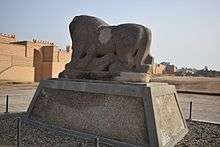Lion of Babylon (statue)



Lion of Babylon is a stone sculpture that was found in the ancient city of Babylon, Iraq.
History
It was discovered in 1876 by a German archaeological mission.
It was initially proposed that the statue was built by the Babylonian king Nebuchadnezzar II (605-562 BC), but the style and materials of the statue have led others to ascribe it to the Hittites.[1] It could have been part of spoils captured by the Babylonians during the campaigns of Nebuchadnezzar II.[2]
In 2013 The World Monuments Fund worked with the Iraq State Board of Antiquities to make improvements to the site. The Lion was cleaned and partially restored, the base of the statue was replaced, and a security barrier was added.[3]
Description
The statue is made out of black basalt black stone; it depicts a Mesopotamian lion standing above a laying human. The statue is two meters in length and the platform upon which it stands is one meter.
Symbolism
The Lion of Babylon is a historic theme in the region. The statue is considered among the most important symbols of (Babylon) in particular and Mesopotamian art in general.[4] The statue is considered a national symbol of Iraq, it has been used by several Iraqi institutions such as the Iraqi Football Association.[5]
See also
References
- ↑ http://www.al-monitor.com/pulse/originals/2016/06/iraq-babylon-culture-heritage.html#ixzz4DYTfkbw6
- ↑ "Babylon, Iraq". Atlastours.net. Retrieved 2016-03-30.
- ↑ https://artsandculture.google.com/exhibit/KgJSt2M6VEvZIQ
- ↑ "Babylon Chronicle, A 1932 photograph of the Lion of Babylon from the". Tammuz.tumblr.com. Retrieved 2016-03-30.
- ↑ "الاتحاد العراقي لكرة القدم". Ifa.iq. Retrieved 2016-03-30.